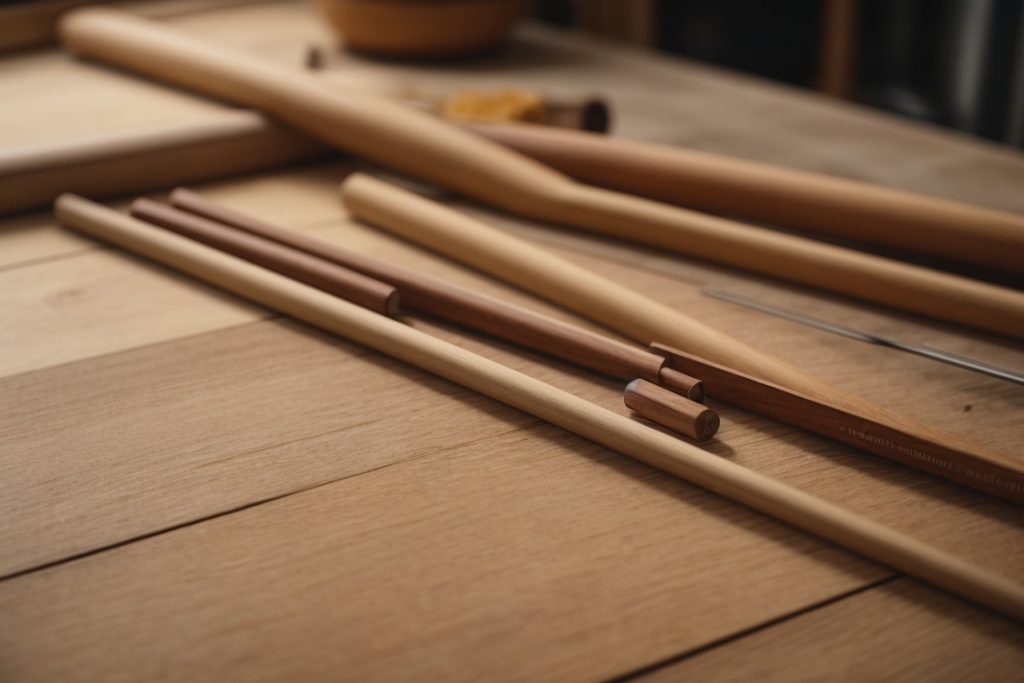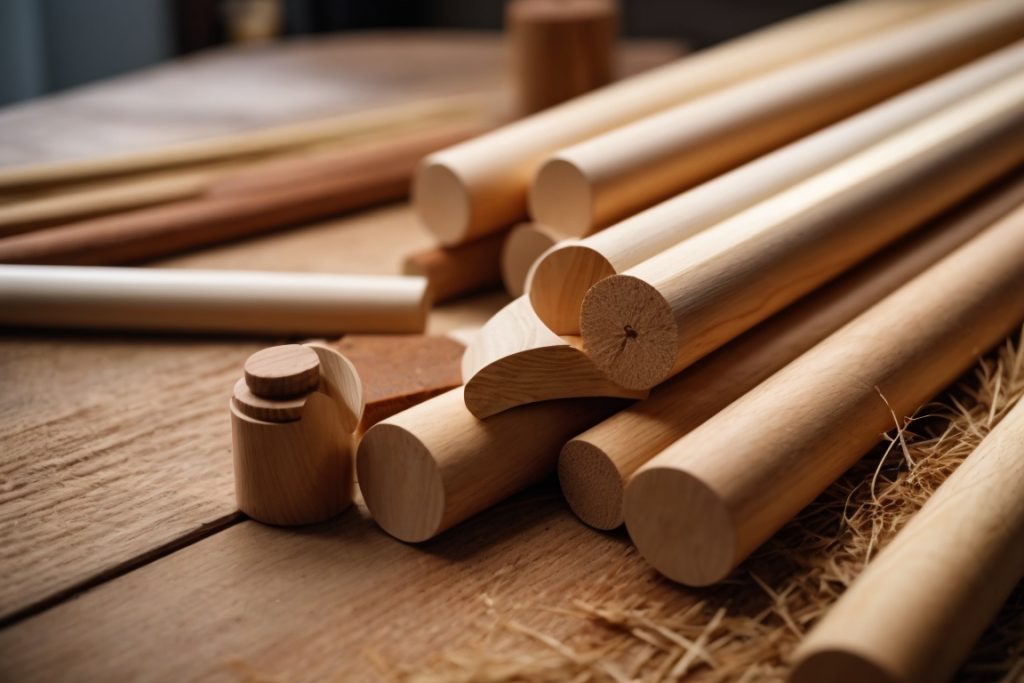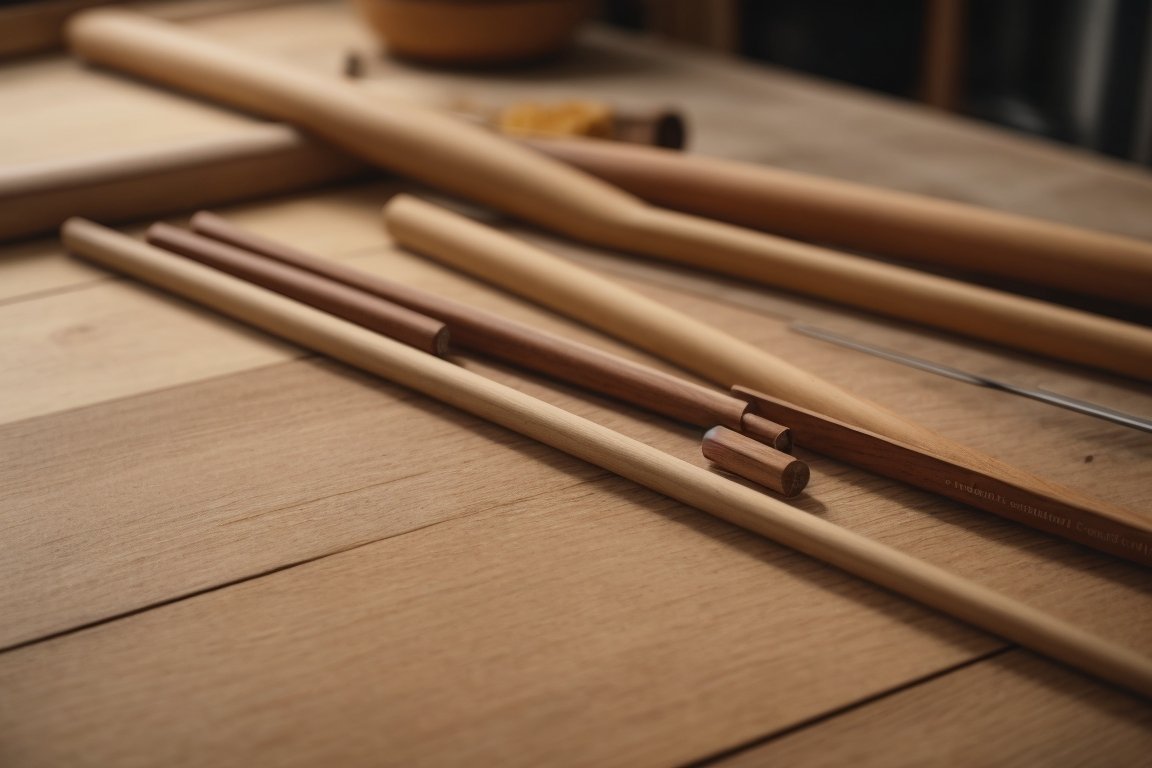Cutting wooden dowels is a common task for those involved in woodworking. Dowels are used as a means of joining two pieces of wood together, or to reinforce a weak or damaged area. If you’re new to woodworking, the process of cutting dowels may seem daunting at first. However, with a few simple steps, you can easily cut wooden dowels to your desired length.
There are several tools and techniques you can use to cut wooden dowels. You can use a table saw, band saw, miter saw, or circular saw to make precise cuts. Alternatively, you can use a cutting jig, serrated knife, or garden shears if you don’t have access to power tools. In this article, we’ll explore the different methods you can use to cut wooden dowels and provide step-by-step instructions to help you get started.
Understanding Wooden Dowels

When it comes to woodworking, wooden dowels are a popular choice for joining two pieces of wood together. They are cylindrical rods made of wood that come in different sizes and lengths. Wooden dowels are versatile and can be used in various woodworking projects, such as furniture, cabinets, and shelves.
Types of Wooden Dowels
There are two main types of wooden dowels: hardwood and softwood. Hardwood dowels are made from deciduous trees, such as oak, maple, and walnut. They are denser and stronger than softwood dowels, making them ideal for heavy-duty projects. Softwood dowels, on the other hand, are made from coniferous trees, such as pine and cedar. They are lightweight and easy to work with, making them suitable for smaller projects.
Choosing the Right Size
Choosing the right size of wooden dowel is crucial for the success of your woodworking project. The size of the dowel you need depends on the thickness of the wood you are joining. A good rule of thumb is to choose a dowel that is one-third the thickness of the wood. For example, if you are joining two pieces of wood that are 1 inch thick, you should choose a dowel that is ⅜ inch in diameter.
Cutting Wooden Dowels
Cutting wooden dowels is a simple process that can be done with a saw or a sharp knife. It is essential to make clean, straight cuts to ensure a tight fit. Before cutting the dowel, mark the length you need with a pencil or marker. Then, use a saw or knife to cut the dowel to size. It is important to be careful and avoid splintering or splitting the dowel when cutting it.
Conclusion
Understanding wooden dowels is essential for any woodworking project. Choosing the right size and type of dowel, as well as cutting it properly, will ensure that your project is successful. Wooden dowels are a versatile and reliable way to join two pieces of wood together, and with a little practice, you can use them to create beautiful and functional pieces of furniture and decor.
Necessary Tools and Materials
When it comes to cutting wooden dowels, having the right tools and materials is essential. Here are the things you will need to get started:
Choosing the Right Saw
The type of saw you use to cut your wooden dowels will depend on the size and shape of the dowel, as well as the type of cut you want to make. Here are some common saws used for cutting dowels:
- Table saw: This is the most common saw used for cutting wooden dowels. It is best for making straight cuts and is ideal for larger dowels.
- Miter saw: This saw is great for making angled cuts and is perfect for smaller dowels.
- Band saw: This saw is ideal for making curved cuts in larger dowels.
- Circular saw: This saw is best for making long, straight cuts on larger dowels.
Selecting Your Dowel
The type of dowel you choose will depend on the project you are working on. Here are some things to consider when selecting your dowel:
- Size: Make sure the dowel is the right size for your project.
- Material: Dowels can be made from a variety of materials, including wood, metal, and plastic. Choose the material that is best suited for your project.
- Shape: Dowels come in a variety of shapes, including round, square, and hexagonal. Choose the shape that is best suited for your project.
Safety Equipment
Whenever you are working with power tools, it is important to take safety precautions. Here are some safety equipment items you should have on hand:
- Safety goggles: Protect your eyes from flying debris.
- Dust mask: Protect your lungs from sawdust.
- Earplugs: Protect your ears from loud noises.
- Work gloves: Protect your hands from sharp edges and splinters.
By having the right tools and materials on hand, you can ensure that your wooden dowel cutting project goes smoothly and safely.
Preparation Steps
Before you start cutting your wooden dowels, it’s important to take some preparation steps to ensure that your cuts are accurate and clean. Here are some tips to help you get started:
Measuring the Dowel
The first step in cutting a wooden dowel is to measure it accurately. Use a ruler or tape measure to determine the length of the dowel you need. Make sure to measure from end to end, and take into account any extra length you may need for your project.
Marking the Cut
Once you have measured your dowel, it’s time to mark the cut. Use a pencil or marker to make a small mark on the dowel where you want to make the cut. Make sure to mark both sides of the dowel to ensure that your cut is straight and even.
If you are cutting multiple dowels to the same length, it can be helpful to use a stop block or jig to ensure that your cuts are consistent. You can also use a clamp or vise to hold the dowel in place while you make your cut.
Remember to take your time and be careful when making your cuts. A clean, accurate cut will ensure that your dowel fits properly in your project and looks professional.
Cutting Techniques

Cutting wooden dowels can be done using various techniques, depending on the tools available and the desired level of precision. In this section, we will discuss three common cutting techniques: using a hand saw, using a miter box, and using a power saw.
Using a Hand Saw
Using a hand saw is a simple and inexpensive way to cut wooden dowels. Here are the steps to follow:
- Mark the dowel at the desired length using a pencil or marker.
- Secure the dowel in a vise or clamp it to a workbench to prevent it from moving.
- Hold the saw at a 45-degree angle and start cutting along the marked line.
- Use a back-and-forth motion to cut through the dowel.
- Sand the cut end of the dowel to remove any rough edges.
Using a Miter Box
A miter box is a tool that helps you make precise cuts at specific angles. Here’s how to use a miter box to cut wooden dowels:
- Place the dowel in the miter box and align it with the desired angle.
- Hold the dowel firmly in place with one hand while using a saw to cut through it with the other hand.
- Repeat the process for each cut needed.
- Sand the cut ends of the dowel to remove any rough edges.
Using a Power Saw
Power saws are efficient and accurate tools for cutting wooden dowels. Here are the steps to follow when using a power saw:
- Choose a power saw that is appropriate for the size and thickness of the dowel.
- Mark the dowel at the desired length using a pencil or marker.
- Secure the dowel in a vise or clamp it to a workbench to prevent it from moving.
- Turn on the power saw and align the blade with the marked line.
- Slowly lower the blade and cut through the dowel.
- Sand the cut end of the dowel to remove any rough edges.
Remember to wear proper safety gear, such as goggles and gloves, when using power saws. Also, be sure to read and follow the manufacturer’s instructions for your specific power saw.
Sanding and Finishing
Once you have cut your wooden dowels to the desired size, it’s important to sand and finish them properly. This will not only improve their appearance but also protect them from damage and wear over time.
Smoothing the Edges
Before you start sanding, use a fine-toothed saw or sandpaper to smooth any rough edges left from cutting the dowels. This will prevent splintering and make the sanding process easier.
Start with a coarse-grit sandpaper, such as 80-grit, and work your way up to a finer grit, such as 220-grit. Sand in the direction of the grain, using a circular motion. Be careful not to sand too aggressively or you may create uneven surfaces or remove too much material.
Once you have sanded the dowels with the finer grit sandpaper, wipe them down with a tack cloth to remove any dust or debris.
Applying Finish
Applying a finish to your wooden dowels will protect them from moisture, stains, and scratches. There are several types of finishes you can use, including varnish, lacquer, shellac, and oil-based finishes.
Before applying any finish, make sure the dowels are clean and free of dust. Apply the finish in thin, even coats, using a brush or cloth. Be sure to follow the manufacturer’s instructions for drying time and number of coats.
After the final coat has dried, use a fine-grit sandpaper, such as 320-grit, to lightly sand the surface of the dowels. This will remove any bumps or imperfections and create a smooth, even finish.
In conclusion, sanding and finishing your wooden dowels is an important step in ensuring their longevity and appearance. By following these simple steps, you can achieve a professional-looking finish that will protect your dowels for years to come.
Troubleshooting Common Issues
Avoiding Splintering
When cutting wooden dowels, splintering can be a common issue. To avoid this, it is important to use the right cutting tool and technique. A handsaw or a sharp knife is recommended for cutting dowels. Make sure to mark the dowel’s length on one end and score the dowel at the mark with a sharp knife. Turn the dowel so the scored end is facing the saw blade and make 1-3 cuts straight down the dowel. Repeat on the other side. This will help prevent splintering.
Another way to avoid splintering is to use a cutting jig. A cutting jig is a tool that helps guide the saw blade and keeps the dowel in place while cutting. This will help prevent the dowel from moving around and causing splintering.
Correcting Uneven Cuts
If you accidentally make an uneven cut while cutting a wooden dowel, don’t worry. There are ways to correct it. One way is to use sandpaper to smooth out the uneven edges. Start with a coarse grit sandpaper and gradually work your way up to a finer grit until the edges are smooth and even.
Another way to correct uneven cuts is to use a dowel plate. A dowel plate is a tool that helps shape and smooth out wooden dowels. Simply insert the dowel into the appropriate size hole and tap it with a hammer until the dowel is shaped and smoothed out.
In conclusion, avoiding splintering and correcting uneven cuts are important steps when cutting wooden dowels. By using the right cutting tool and technique, and utilizing tools like a cutting jig or dowel plate, you can achieve clean and precise cuts without any issues.
